Are you tossing and turning at night? Poor sleep can ruin your day. Plants in your bedroom can help you sleep better and breathe cleaner air. This guide will show you the best plants for your bedroom.
Ready to green up your sleep space?
Key Takeaways
Snake plants, ZZ plants, lavender, monstera, pothos, and peace lilies are top choices for bedroom plants.
These plants improve air quality by removing toxins like formaldehyde and benzene from the air.
Lavender helps reduce stress and promotes better sleep with its calming scent.
Most of these plants are low-maintenance and can thrive in various light conditions.
Peace lilies increase humidity, which can help soothe dry throats and noses while sleeping.
Table of Contents
Choosing the Right Plants for Your Bedroom
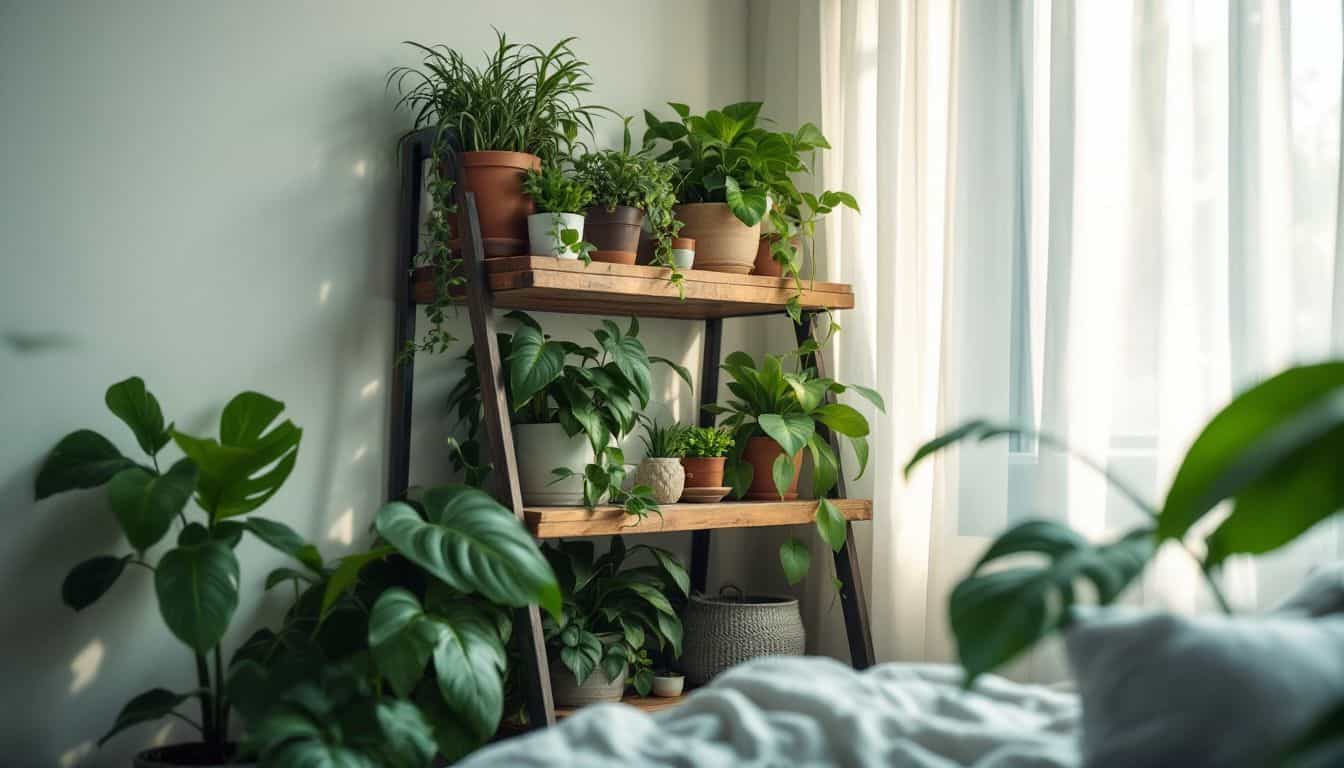
Picking plants for your bedroom isn’t just about looks. It’s about finding green buddies that’ll help you sleep better and breathe easier. Let’s dive into what makes a plant perfect for your nighttime nook!
Evaluating Air Purification Qualities

Plants can be your secret weapon for cleaner air. Some leafy friends are champs at sucking up nasty stuff like benzene and formaldehyde. Take the peace lily – it’s a pro at detoxifying your bedroom air.
And the snake plant? It’s a night owl, filtering toxins and pumping out oxygen while you snooze.
I’ve got a snake plant in my bedroom, and let me tell you – it’s a game-changer. My allergies have calmed down, and I wake up feeling fresher. When picking plants, look for ones that tackle common indoor pollutants.
Spider plants are great all-rounders, gobbling up various icky particles. Just pop a few green buddies around your room, and breathe easy!
Assessing Light Requirements
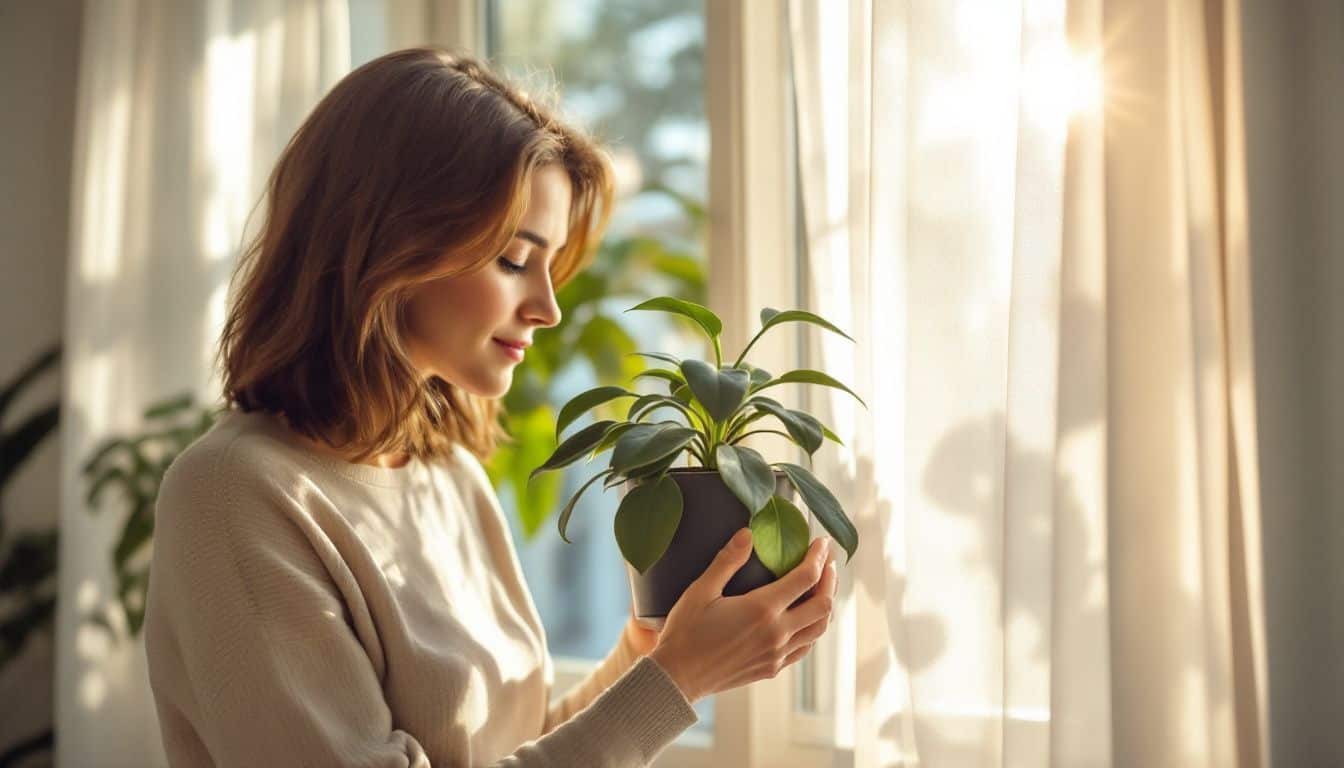
After looking at how plants clean the air, let’s chat about light. Plants need light to grow, just like we need food. Some plants love bright light, while others do fine in darker spots.
Think about where you’ll put your plant in your bedroom. Is it near a window? Or in a corner? Different plants like different amounts of light. For example, the Rubber Plant likes bright, indirect light.
But the Snake Plant can grow in many light conditions. It can even get 12 to 36 inches tall! The Dracaena Limelight does best in indirect sunlight. If you’re looking for window treatments in Solana Beach, you’ll find great options to help control the light for your plants.
The right light helps your plants thrive and look their best.
Light is to plants what food is to humans – essential for growth and health.
Considering Maintenance Levels
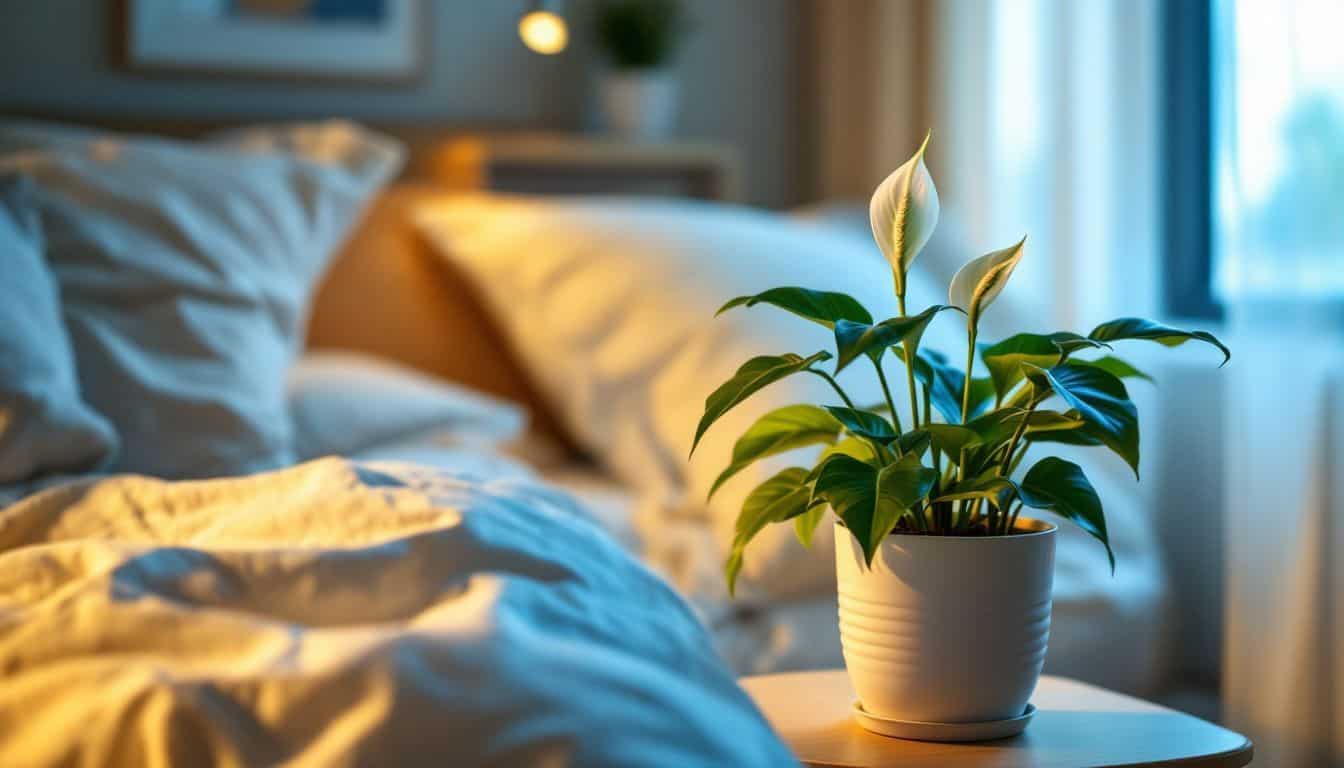
Picking plants for your bedroom isn’t just about looks. You’ve got to think about how much work they need, too. Some plants are like needy pets – they want attention all the time.
Others? They’re cool with you forgetting about them for a while. Take the Peace Lily, for example. It’s pretty chill. You only need to water it every 7–10 days when it’s warm, and every two weeks when it’s cold.
But watch out! Too much water can make its roots rot. Stick your finger in the soil to check if it needs a drink.
Let’s be real – we’re all busy. So, easy-care plants are a win. They clean the air and make your room look great without adding to your to-do list. Just keep in mind, even easy plants need some love.
A little care goes a long way in keeping your green buddies happy and healthy. And trust me, there’s nothing like waking up to a thriving plant to start your day right!
Top Air Purifying Plant: Snake Plant
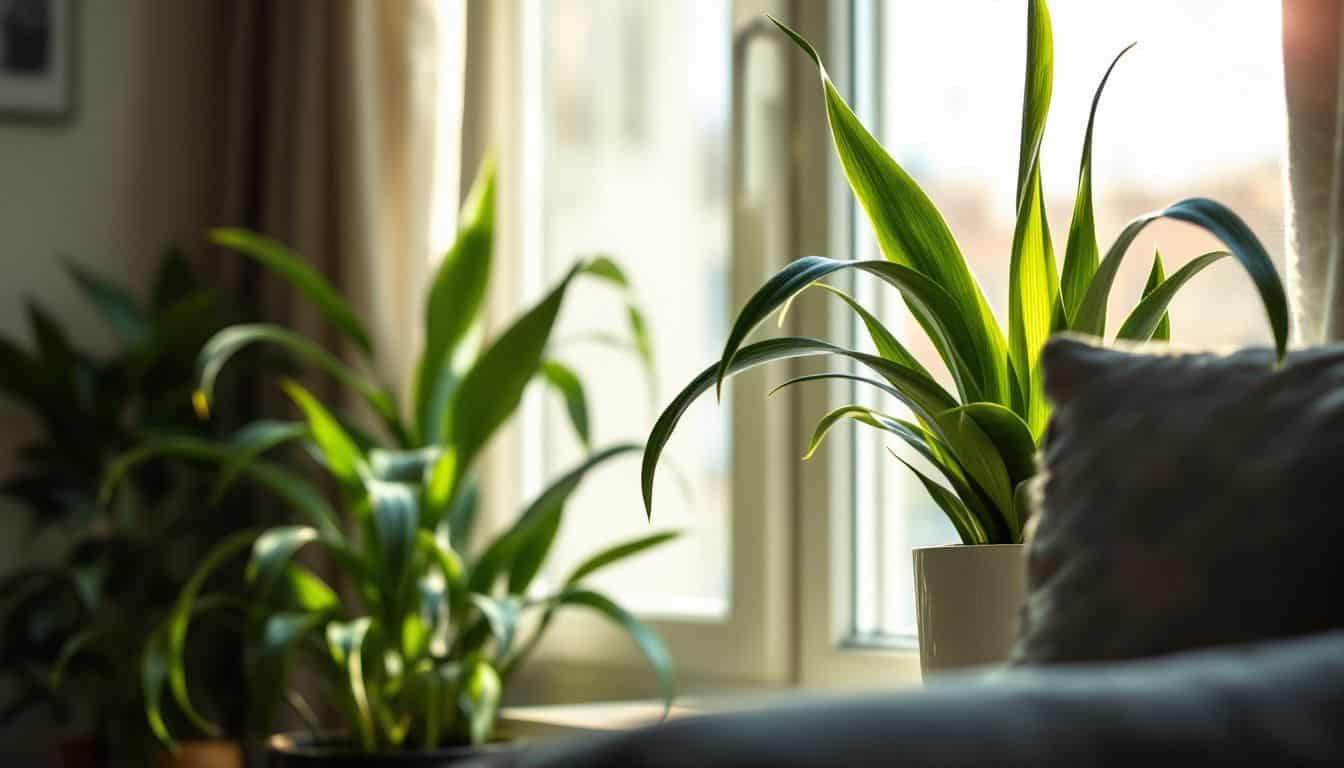
Snake plants are air-cleaning champs. They suck up toxins and pump out fresh oxygen – even at night!
Features & Benefits of Snake Plant

Snake plants are nature’s air purifiers. These tough green warriors work tirelessly to clean your bedroom air. They suck up nasty chemicals like formaldehyde and benzene. At night, they’re busy releasing fresh oxygen – perfect for better sleep! Plus, they’re a breeze to care for.
You don’t need a green thumb to keep these guys happy.
But heads up, pet owners! Snake plants can be toxic to furry friends. If Fluffy or Fido nibbles on the leaves, it might cause tummy troubles. Still, with proper placement, snake plants can be a great addition when you decorate the bedroom.
They’re stylish and functional – a win-win for any sleep space. Now, let’s talk about how to keep your new air-cleaning buddy thriving.
Snake plants: Nature’s nighttime air fresheners for your bedroom.
Snake Plant Care Instructions

Snake plants are tough cookies that can thrive with minimal care. Here’s how to keep your snake plant happy and healthy:
- Light: These plants love medium light but can handle low or bright spots too. Just keep them out of direct, hot sun.
- Water: Let the soil dry out between drinks. Water every 2–8 weeks, depending on how warm and bright your room is.
- Soil: Use a well-draining potting mix. Cactus soil works great for these succulents.
- Humidity: No need to fuss! Snake plants are cool with average indoor humidity levels.
- Temperature: These plants are pretty chill. They’re happy in most home temperatures, from 60°F to 80°F.
- Fertilizer: Feed your snake plant lightly during spring and summer. Use a balanced, water-soluble fertilizer once a month.
- Propagation: Want more snake plants? Cut a leaf into sections and pop them in soil. Or, divide the plant when repotting.
- Repotting: These guys like to be a bit root-bound. Repot every 2–3 years or when roots start peeking out of the pot.
- Cleaning: Wipe the leaves with a damp cloth now and then to keep them dust-free and shiny.
- Pests: Snake plants rarely get bugs, but keep an eye out for mealybugs or spider mites. If you spot any, wipe them off with soapy water.
Ideal for Low Light Conditions: ZZ Plant
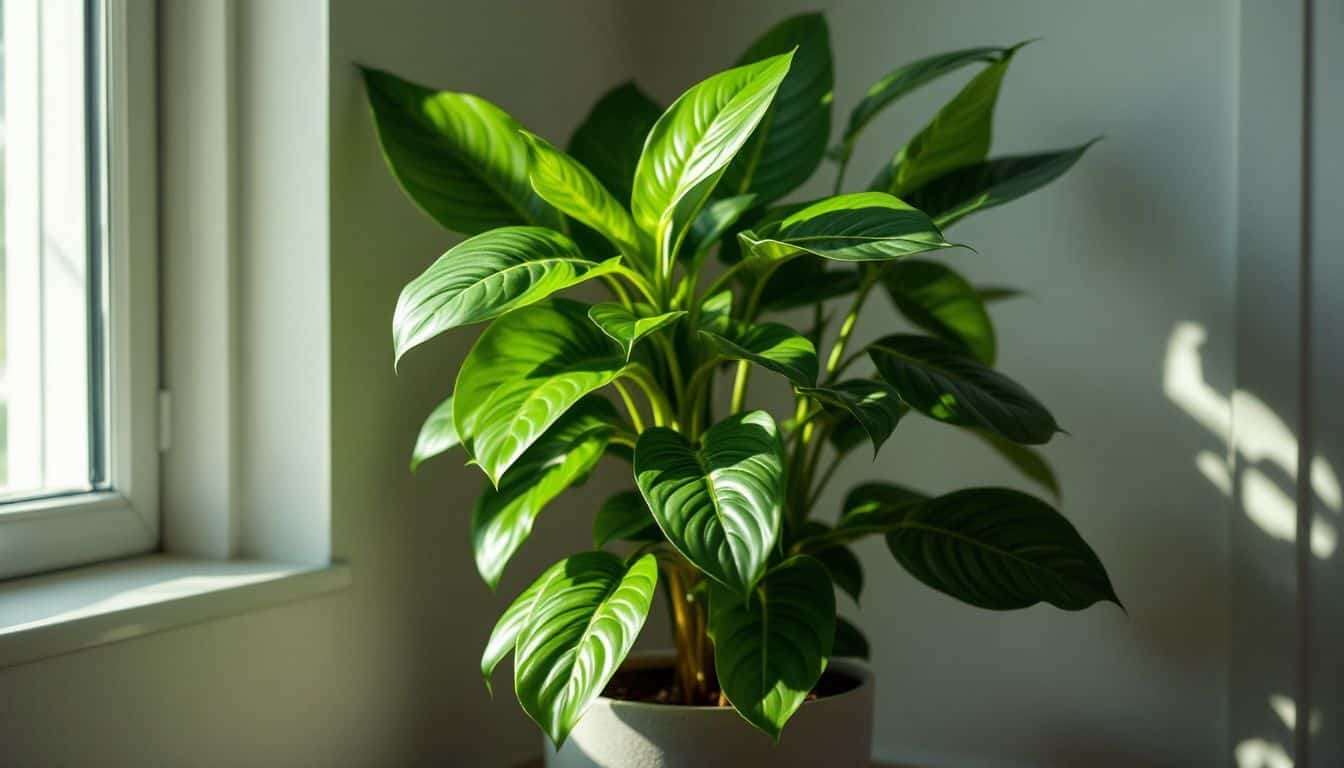
ZZ plants are tough cookies! They thrive in low light and don’t need much water. If you’re looking for a plant that won’t die on you, this might be your new best friend.
Features & Benefits of ZZ Plant
ZZ plants are tough cookies. They thrive in low light and don’t need much water. This makes them perfect for busy folks or those with not-so-green thumbs. These plants are like nature’s air purifiers, sucking up nasty toxins from the air.
They’re also pretty low-maintenance – you can forget about them for weeks, and they’ll still look great.
I’ve had a ZZ plant for years, and it’s been a champ. It sits in a dark corner of my bedroom and only gets watered once a month. Yet, it keeps growing and looking lush. The glossy, dark green leaves add a touch of elegance to any space.
ZZ plants are the superheroes of the plant world – they can survive almost anything!
Plus, they’re said to bring good luck – who couldn’t use a bit more of that?
ZZ Plant Care Instructions
Now that we’ve covered the perks of ZZ plants, let’s dive into how to care for them. These tough cookies are pretty low-maintenance, but they still need some TLC to thrive.
- Watering: ZZ plants are drought-tolerant champs. Water them every 2–3 weeks in summer and 3–4 weeks in winter. Let the soil dry out between waterings to avoid root rot.
- Light: These plants are happy in low to bright indirect light. They can even handle fluorescent office lighting like pros.
- Soil: Use a well-draining potting mix. Add some perlite or sand to improve drainage if needed.
- Humidity: ZZ plants adapt to low humidity but prefer it higher. Mist them occasionally or place a pebble tray nearby for extra moisture.
- Fertilizer: Feed your ZZ plant with a balanced, water-soluble fertilizer once a month during spring and summer. Skip fertilizing in fall and winter.
- Pruning: These plants don’t need much pruning. Just snip off any yellow or dead leaves to keep them looking fresh.
- Propagation: Divide the plant or root stem cuttings in water or soil to make more ZZ plants. It’s like magic!
- Pest control: Keep an eye out for mealybugs and spider mites. If you spot any, treat them early with insecticidal soap or neem oil.
- Repotting: ZZ plants like to be a bit root-bound. Repot every 2–3 years or when roots start peeking out of the drainage holes.
- Safety: ZZ plants are toxic if ingested. Keep them away from curious pets and kiddos.
The Best Plant for Stress Relief: Lavender

Feeling stressed? Lavender might be your new best friend. This pretty purple plant isn’t just nice to look at – it’s a natural chill pill for your bedroom.
Features & Benefits of Lavender
Lavender is a powerhouse for your bedroom. Its sweet scent isn’t just nice – it’s a natural sleep aid. Many moms swear by it for their babies. A whiff of lavender can calm fussy little ones and help them drift off to dreamland.
But it’s not just for kids! Adults can reap the benefits too.
This pretty purple plant does more than look good. It creates a peaceful vibe in your room. Feeling stressed? Lavender’s got your back. It’s like having a mini spa right by your bed.
Plus, it’s tough as nails. You don’t need a green thumb to keep it alive. Just give it a little water now and then, and it’ll thrive. Talk about low-maintenance beauty!
Lavender Care Instructions
Now that we’ve covered the perks of lavender, let’s dive into how to keep it happy. Caring for this sweet-smelling plant isn’t rocket science, but it does need some TLC. Here’s what you need to know:
- Sunlight: Lavender loves basking in direct sunlight. Place it near a sunny window where it can soak up those rays for at least 6 hours a day.
- Watering: Don’t drown your lavender! Water it only when the soil feels dry to the touch. Overwatering is a big no-no.
- Soil: Use well-draining soil to keep your lavender’s roots happy. Mix in some sand or perlite to improve drainage.
- Pot size: Choose a pot that’s just right – not too big, not too small. Lavender likes its roots snug.
- Pruning: Give your lavender a haircut now and then. Trim it back after flowering to keep it bushy and healthy.
- Humidity: Lavender isn’t a fan of high humidity. If your bedroom’s too damp, use a dehumidifier or place it near an open window.
- Fertilizer: Go easy on the plant food. Lavender doesn’t need much – once a year in spring is plenty.
- Indoor varieties: For bedrooms, pick compact lavender types like ‘Munstead’ or ‘Hidcote’. They’re perfect for smaller spaces.
Most Aesthetically Pleasing: Monstera
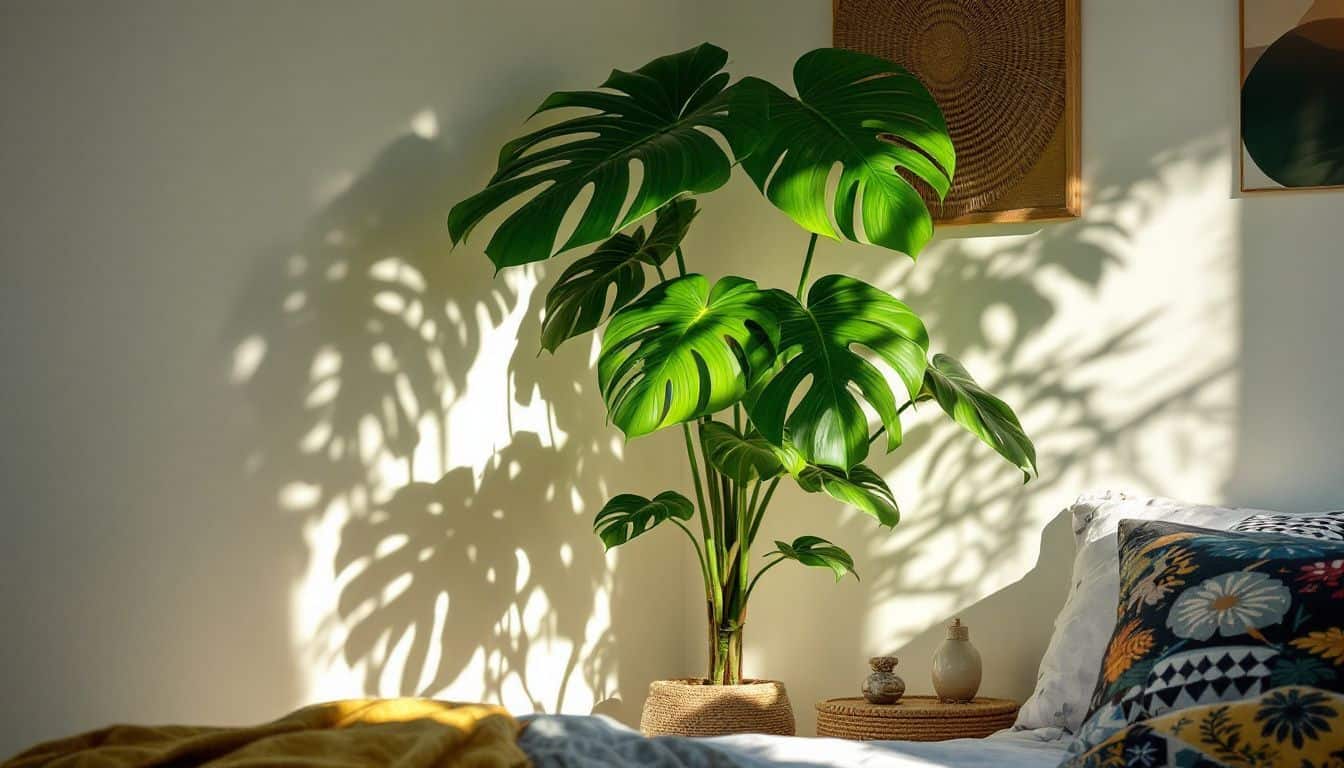
Monstera plants are a showstopper in any bedroom. Their big, holey leaves add a touch of jungle charm that’s hard to beat.
Features & Benefits of Monstera
Monstera plants bring a touch of the tropics to any bedroom. Their big, glossy leaves with unique holes make them a real eye-catcher. These plants aren’t just pretty – they’re great air cleaners too.
They suck up nasty toxins from the air, helping you breathe easier while you sleep.
But wait, there’s more! Monsteras are tough cookies. They can handle a bit of neglect, perfect for busy folks or newbie plant parents. Plus, they grow fast, giving you a lush, green oasis in no time.
Just be careful if you have pets or kids – the leaves can be toxic if eaten. As someone who’s had a Monstera for years, I can vouch for their mood-boosting power. There’s nothing like waking up to those beautiful, split leaves every morning.
A room without plants is like a life without meaning. – Unknown
Monstera Care Instructions
Monstera plants are a stunning addition to any bedroom. Here’s how to keep your Swiss cheese plant happy and thriving:
- Light: Place your Monstera in bright, indirect light. Keep it away from harsh sun rays to avoid leaf burn.
- Water: Let the top half of the soil dry out between waterings. Don’t let your plant sit in water – it hates wet feet!
- Humidity: Mist leaves often or use a pebble tray. These tropical beauties love moist air.
- Temperature: Keep your Monstera cozy above 60°F. It’ll thank you with lush growth.
- Soil: Use a well-draining potting mix. Add some perlite or orchid bark for extra drainage.
- Fertilizer: Feed monthly during spring and summer with a balanced houseplant food.
- Pruning: Trim yellowing or damaged leaves to keep your plant looking its best.
- Support: Give your Monstera a moss pole or trellis to climb. It loves to show off its aerial roots!
- Propagation: To make baby Monsteras, cut a leaf with a node and pop it in water. Roots will grow in no time.
- Cleaning: Wipe leaves with a damp cloth to keep them dust-free and shiny.
Easiest to Maintain: Pothos
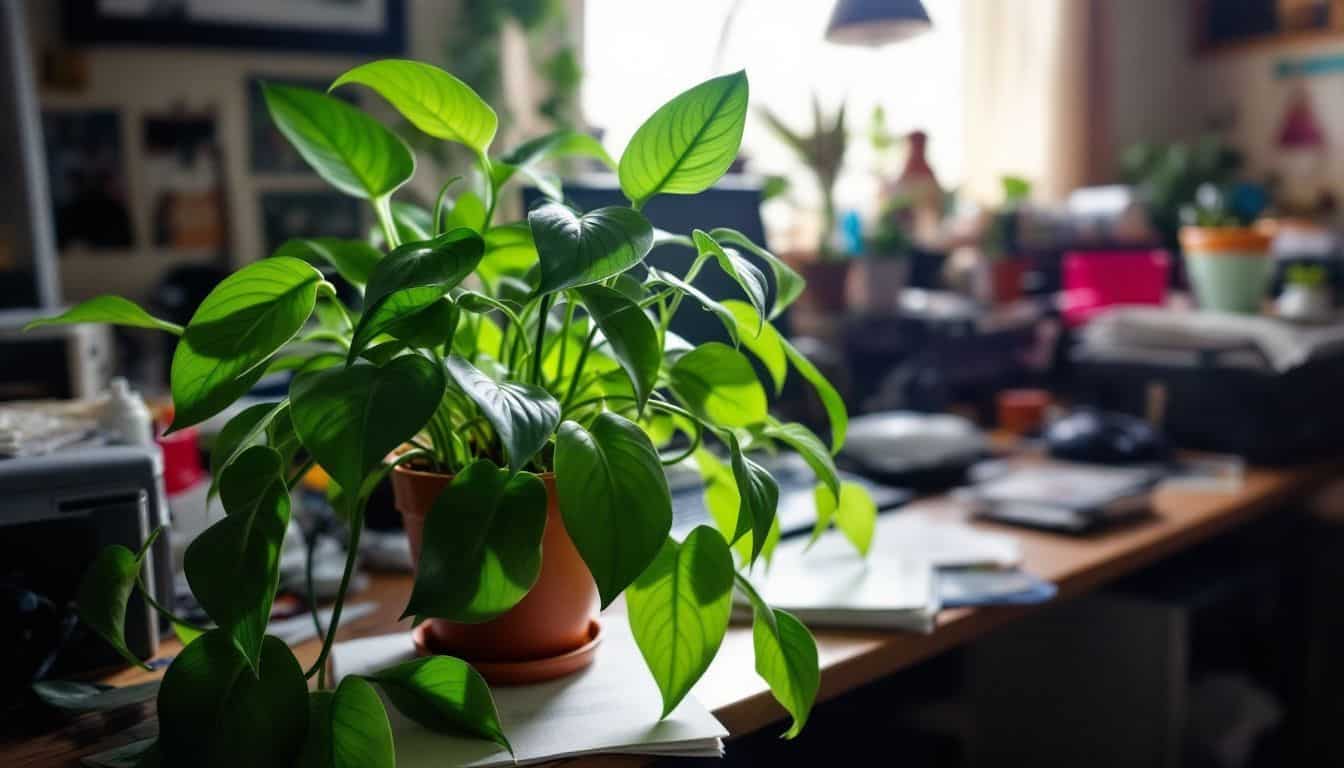
Pothos is a dream come true for busy plant parents. It’s tough as nails and can thrive even if you forget to water it now and then.
Features & Benefits of Pothos
Pothos is a star at cleaning indoor air. This leafy plant absorbs harmful substances like formaldehyde and benzene, making your bedroom healthier. Its trailing nature is great for hanging baskets or plant stands, adding a green touch to any space.
It’s also tough – thriving in low light and needing little care.
Taking care of pothos is easy. Let the top inch of soil dry between waterings, and you’re set. Golden pothos is a popular type, along with Jade, Marble Queen, and Neon. Each adds its own style to your decor.
Here’s how to keep your pothos happy and growing well.
Pothos Care Instructions
Pothos plants are a breeze to care for, making them perfect for busy women. Here’s how to keep your pothos happy and thriving:
- Light: These plants love bright, indirect light but can handle low light too. Just don’t put them in direct sun – it’ll burn their leaves.
- Water: Let the soil dry out between waterings. Stick your finger in the soil – if it’s dry an inch down, it’s time to water.
- Soil: Use well-draining potting mix. Pothos aren’t picky, but they hate wet feet.
- Feeding: Give them a balanced liquid fertilizer once a month during spring and summer.
- Pruning: Trim long vines to keep your plant bushy. Bonus: you can root the cuttings in water for new plants!
- Pests: Watch out for spider mites and mealybugs. If you spot any, wipe leaves with neem oil.
- Propagation: It’s super easy! Cut a stem with a few leaves, pop it in water, and watch roots grow.
- Cleaning: Dust leaves with a damp cloth to keep them shiny and healthy.
- Temperature: Pothos like it warm – between 60-80°F is ideal.
- Humidity: They’re not fussy, but a little extra moisture in the air makes them happy.
Optimal for Humidity: Peace Lily
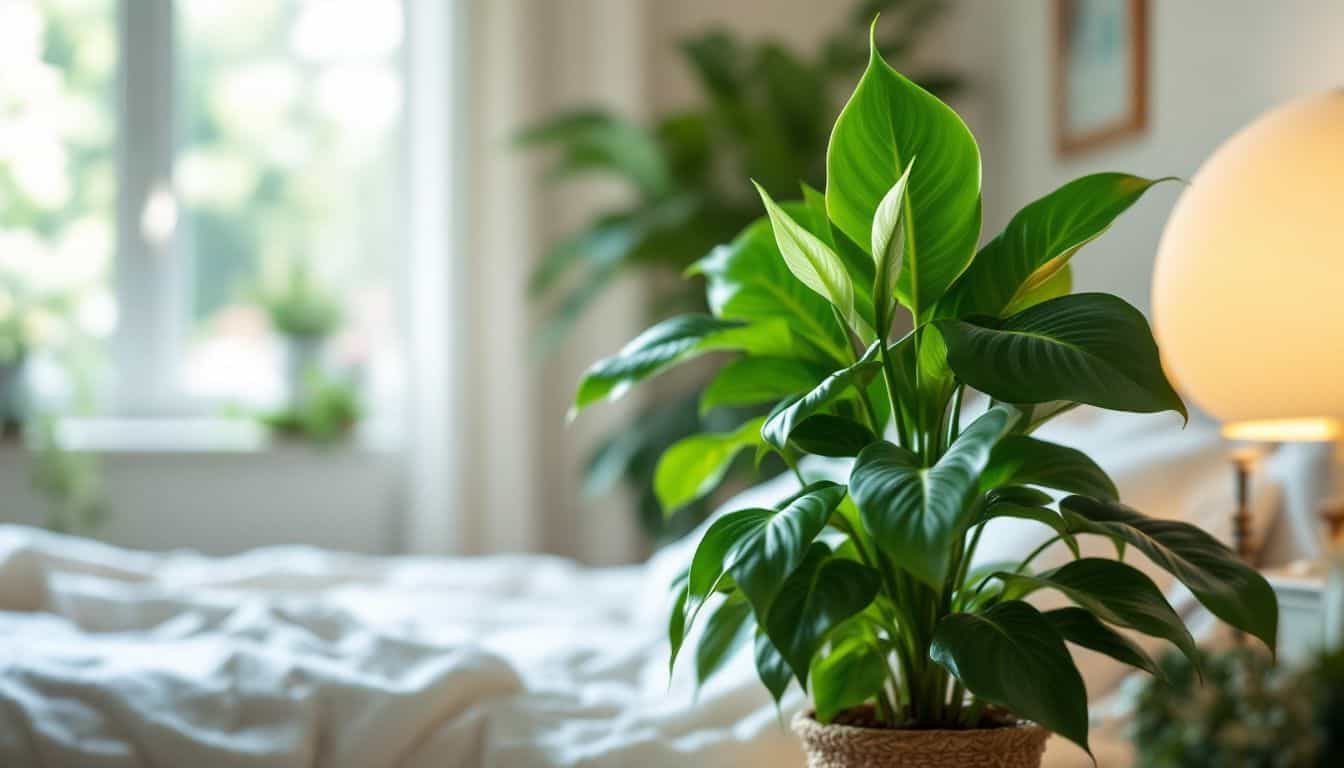
Peace Lilies are champs at boosting humidity. They’re perfect for bedrooms, especially if you struggle with dry air.
Features & Benefits of Peace Lily
Peace lilies are more than just pretty faces. These lovely plants pack a punch when it comes to cleaning your air. They’re great at soaking up harmful stuff like acetone from nail polish remover.
Plus, they add a touch of humidity to your room – great for soothing dry throats and noses.
And there’s more! Peace lilies are tough cookies. They can handle low light and don’t need much fuss. Got pets? No worries. These plants are generally safe, though they might cause a bit of tummy trouble if Fluffy decides to snack on them.
With their elegant white blooms, peace lilies bring a dash of calm to any bedroom. It’s like having your own little slice of zen right on your nightstand.
Peace Lily Care Instructions
Now that we’ve covered the perks of peace lilies, let’s dive into how to care for these beauties. Keeping your peace lily happy isn’t rocket science, but it does require a bit of know-how. Here’s your easy-peasy guide to peace lily care:
- Light: These plants love indirect light. Pop them near a window with a sheer curtain for best results.
- Water: Keep the soil moist, but don’t drown your plant. Water when the top inch of soil feels dry.
- Temperature: Peace lilies thrive in temps between 60-80°F. Avoid drafty spots or sudden temp changes.
- Soil: Use well-draining potting mix. These plants aren’t picky, but they do like their roots to breathe.
- Humidity: Mist leaves often or use a pebble tray. These tropical beauties love a bit of moisture in the air.
- Feeding: Give your plant a half-strength liquid fertilizer once a month during spring and summer.
- Pruning: Snip off yellow or brown leaves at the base. It keeps your plant looking fresh and fab.
- Repotting: Every 1–2 years, move your peace lily to a slightly larger pot. Spring is the best time for this.
- Cleaning: Wipe leaves with a damp cloth now and then. It helps your plant breathe better and look glossy.
- Toxicity: Keep pets and kids away. Peace lilies can be harmful if eaten, so it’s best to play it safe.
People Also Ask
What are the top bedroom plants for better sleep and air quality?
The best plants for your bedroom include English Ivy, Snake Plant (Dracaena trifasciata), Boston Fern, Aloe Vera, Peace Lily, and Spider Plant. These green buddies help clean the air and might even help you catch some Z’s.
How do indoor plants improve air quality?
Indoor plants act like nature’s air purifiers. They suck up nasty stuff like VOCs and fine dust. Some, like the Boston Fern, are champs at removing particulate matter. It’s like having a tiny, leafy army fighting air pollution in your room.
Can bedroom plants really help me sleep better?
You bet! Some plants, like Lavender, give off calming scents that can help you drift off to dreamland. Others, like the Snake Plant, keep pumping out oxygen at night. It’s like having a sleep-friendly DJ spinning relaxing tunes all night long.
Are there any low-maintenance plants for lazy plant parents?
Absolutely! Cacti and succulents like the Jade Plant (Crassula ovata) are perfect for folks with brown thumbs. They’re tough as nails and can handle a bit of neglect. Just don’t forget about them completely!
What if I have pets? Are there safe bedroom plants?
Good news, pet parents! Many plants are pet-friendly. The Boston Fern, Spider Plant, and Money Tree are safe for curious cats and dogs. But always double-check before bringing any new greenery home. Your furry friends will thank you!
How many plants do I need in my bedroom for better air quality?
There’s no magic number, but more is often better. Start with 2-3 plants and see how it goes. Mix it up with different types like the Parlor Palm, Chinese Evergreen, and Monstera deliciosa. Your bedroom will feel like a mini jungle in no time!
References
https://www.architecturaldigest.com/story/the-best-plants-for-bedroom (2024-04-23)
https://www.goodhousekeeping.com/home/gardening/g32579496/best-bedroom-plants/ (2024-08-21)
https://www.healthline.com/health/benefits-of-snake-plant (2022-01-24)
https://www.joyusgarden.com/sansevierias-snake-plant-care/ (2023-08-17)
https://nouveauraw.com/indoor-plants/varieties/zz-plant/
https://homegarden.cahnr.uconn.edu/factsheets/zz-plant/
https://www.joyusgarden.com/zz-plant-care-tips/ (2023-10-23)
https://www.dreams.co.uk/sleep-matters-club/11-bedroom-plants-to-help-you-sleep-better
https://florasense.com/blogs/best-plants-for-the-bedroom-enhance-air-quality-and-sleep/
https://greg.app/monstera-benefits/ (2023-12-16)
https://food52.com/blog/25437-monstera-swiss-cheese-plant-care-guide (2020-03-20)
https://www.gardendesign.com/houseplants/pothos.html
https://www.thespruce.com/pothos-an-easy-to-grow-houseplant-1403154
https://nurserylive.com/blogs/plant-talk/the-peace-lily-guide-benefits-care-propagation-and-more
